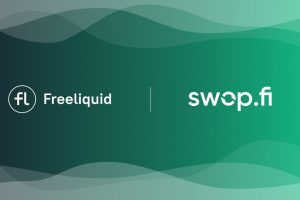DeFi Credit Protocols Are Reshaping the Lending Market – A Case Study of Freeliquid

For decades, banks have created friction-intensive lending processes that incur huge interest rates and intrusive checks into people’s private affairs. As part of the traditional financial market, funding a loan entails identity checks, credit checks, income checks, as well as collateralization of real-world assets. After at least a few days of planning and discussing with a loan advisor, a credit is finally given, not without signing extensive paperwork and unofficially selling your soul to the lending institution.
Such is the case with most of the world’s traditional lending providers – and whilst the process could be simplified, it isn’t. DeFi has therefore positively disrupted the lending market by creating inclusive protocols which seamlessly fund fiat and crypto-based loans through simple crypto asset collateralization.
The steps to funding a DeFi loan
Got some idle crypto that’s growing in value? Need some additional liquidity, but are unwilling to sell your high-yield assets? Worry not – DeFi has your back covered. Most protocols fund loans in a value ranging from 50% – 90% of your crypto collateral, incurring marginal interest rates. None of the traditional fiasco applies, as smart contracts rule over the entire process.
Therefore, the steps are simple – find a lending provider, deposit your assets, access a loan. That’s it – plain and simple! But it gets better…
What if your crypto assets are deposited in a liquidity pool?
If this is the case, most DeFi lending protocols won’t fund your loans. After all, you’re already earning an annual percentage yield via your favourite automated market maker’s liquidity pools. Can’t settle for less? Well, you shouldn’t. Here’s where Freeliquid comes into play!
Freeliquid was designed to help liquidity providers obtain additional funding without having to sell their assets or deposit additional fiat. As an interest-free stablecoin lending protocol, Freeliquid works by collateralizing LP tokens originating from Uniswap and Curve’s 3pool. Loans corresponding to 90% of your LP shares are funded in USDFL, an algorithmic stablecoin whose value tracks the USD.
What can I do with a LP-collateralized loan?
Plenty! In fact, the opportunities are virtually endless. Let’s assume that you hold $10K-worth of stablecoin liquidity pool shares. Simply collateralize your LPs via Freeliquid’s audited smart contracts, and you’ll instantly obtain $9,000 in USDFL. These tokens can then be introduced in yet another liquidity pool, minting additional LP tokens. Collateralization can take place a few times over, leading to incredible APYs.
Of course, USDFL can also be used for non-LP purposes. Since USDFL trading pairs with sufficient liquidity are available on several trading platforms like Uniswap, Curve, or Waves, the lending stablecoin can be converted to other emerging tokens, accessing profits obtained via organic coin value growth.
How about Freeliquid’s lending terms?
Nothing complicated, and that’s a promise! At press time, Freeliquid’s loans do not incur interest rates, stability fees, or liquidation risks. Similarly, flexible terms are provided, meaning that access to your LPs is regained as soon as the loan is repaid – so you make your own terms.
When lending via Freeliquid, users retain the APY and other rewards provided by their favourite AMM. For instance, Curve’s 3pool users retain CRV rewards, whereas FL/USDN liquidity providers on Swop.Fi are rewarded $SWOP tokens on top of the standard share of the incurred transaction fees.
But who governs Freeliquid?
You do, but as long as you own FL, the protocol’s governance token, fairly distributed to participants as liquidity providing incentives. FL token holders thereby vote on any and all developments, including expansions to other chains and integrations with additional AMMs or CEXs.
Is now a good time to get involved?
Certainly! Freeliquid came to be via a stealth launch, with no marketing carried out in its early days in hopes of rewarding early adopters. The protocol is still in its early days, albeit it’s now hitting the mainstream market, as thousands of people worldwide recognize the value posed by its unique value proposition.
As always, Freeliquid will constantly work on user incentives, lucrative expansions, and positive integrations. Scheduled for the 2nd quarter of the current year, Freeliquid will see an expansion to the Binance Smart Chain, welcoming a wave of new liquidity providers who are involved with billion-dollar AMMs like PancakeSwap.
To learn more, check out Freeliquid’s website, Medium, Twitter, and Telegram communities.
Source: Read Full Article

